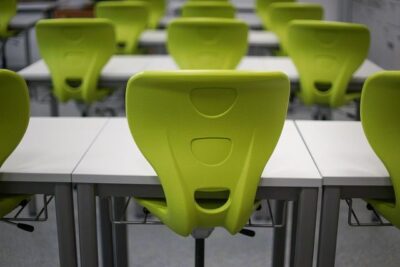Fancy a peek at what future classrooms are going to look like?
Get comfy and let’s see together. The ugly days of fixed, uncomfortable school desks will soon become history.
Schools are starting to acknowledge that old-fashioned school furniture just doesn’t work anymore.
And when 32% of schools report improved performance when integrating new educational technology, the shift is happening fast.
Here’s the issue:
Students spend thousands of hours seated in tight, uncomfortable positions at school desks that don’t fit their bodies.
Studies show 74.2% of students feel their desk height is unsuitable, contributing to poor posture, lack of concentration, and long-term musculoskeletal problems.
And… here’s the good news…
The future of school desk technology is set to change the way students learn, collaborate, and stay healthy in the classroom.
You’ll find out:
- Smart Desk Technology Integration
- Height-Adjustable and Ergonomic Solutions
- Collaborative Learning Surfaces
- Sustainable and Eco-Friendly Materials
- Tech-Enabled Storage Solutions
Smart Desk Technology Integration
Classroom desks are the central hub for digital learning.
In previous years, desks served as places to keep books, pencils, and computers.
But smart desks these days are equipped with the kind of technology that directly and seamlessly links up with 21st-century learning.
Wireless charging surfaces are integrated directly into desk materials. Students simply place devices in specific spots on desk surfaces and tablets and smartphones charge wirelessly without cables. No more tangled cords and dead devices.
Built-in touch screens create interactive, flexible work surfaces. Screens can display assignments, access interactive learning modules or serve as digital whiteboards. Students solve math equations on desk surfaces or manipulate 3D models with their fingertips.
Power management features built-in USB ports, wireless charging pads and battery packs that are not reliant on wall outlets. Students have power wherever desks are set up in flexible learning environments.
Height-Adjustable and Ergonomic Solutions
The biggest game-changer? Desks designed for every body type.
Adjustable student desks are the vanguard in ergonomic classroom furniture. These revolutionary new products respond to the physical diversity of students and foster healthier learning postures.
Pneumatic height adjustment systems make it simple for students to adjust desk heights to their ideal ergonomic position. Simple lever systems allow desks to change from primary to high school height in a matter of seconds. Students easily adjust height for different tasks such as writing, typing, or collaboration.
Sit-stand desks are quickly becoming the norm in progressive schools. Studies show switching between sitting and standing postures increase concentration and engagement. These versatile desks encourage movement throughout the day and combat the ill-effects of long-term sitting.
Memory foam work surfaces and curved desk edges replace hard, pointy desk tops. Ergonomic improvements to reduce pressure points and increase comfort during long study periods.
The end result is that students concentrate for longer, feel less physical discomfort, and form better posture habits that will serve them for life.
Collaborative Learning Surfaces
Flexible furniture that supports the various learning styles
Modular desk systems replace rigid classroom layouts of the past. Wheels, light-weight materials and connecting mechanisms allow teachers to reconfigure spaces in minutes. Students can work individually, in pairs, or in large groups without struggling to move heavy furniture around.
Writable desk surfaces with special coatings eliminate the need for separate whiteboards. Dry erase markers can write directly on desks and turn every work surface into a brainstorming space. Wipe clean with the end of the lesson and desks are ready for the next activity.
Magnetic integration into desktops enables instant material sharing. Students attach notes, worksheets or small devices directly to work surfaces to create organized, accessible workspaces that support active learning.
These collaborative features reflect the new reality in modern education that learning is no longer one-size-fits-all. But instead centers on student-centered exploration, teamwork, and differentiated teaching methods.
Sustainable and Eco-Friendly Materials
Environmental consciousness impacts school desk design choices.
Schools are starting to choose desks made from recycled materials and sustainable sources. Furniture manufacturers respond with desks crafted from recycled plastics, reclaimed wood and sustainably-sourced metals. These eco-friendly materials both minimize environmental impact and teach students the value of sustainability.
Low-VOC and non-toxic finishes and materials become standard expectations. The schools understand that indoor air quality impacts student health and ability to learn. New desk finishes eliminate harmful chemicals without sacrificing durability or easy cleanup.
Modular desk designs allow for desks to be repaired, upgraded or reconfigured rather than being thrown away and replaced. Waste is minimized and schools get long-term value out of investment in school furniture.
The school furniture market is expected to hit USD 9.35 billion by 2030 and sustainability is a key factor in decision-making.
Tech-Enabled Storage Solutions
Organization and innovation intersect in next-gen desk storage.
Smart lockers built into desk pedestals feature electronic locks that students open with ID cards or biometric scanners. Lost keys are a thing of the past and safe storage for valuable devices.
Cable management systems hide and organize the myriad of chargers, adapters and cords that modern learning demands. Hidden channels and pop-up sockets keep work surfaces tidy while still providing easy access to power and data connections.
Inventory tracking technologies are embedded into storage compartments. RFID tags and sensors track which supplies students use and notify teachers when items need restocking.
These storage solutions answer the modern reality that today’s students have more technology to carry and need more organizational support than ever before.
The Connected Classroom: What’s Next?
The future holds even more exciting possibilities.
AI-powered desk adjustment learns each individual student’s height, lighting and temperature preferences and automatically configures the settings whenever a student sits down. Facial recognition or ID card scanning can trigger desk adjustments to each child’s personalized setup.
Biometric health monitoring embedded into desk surfaces will monitor posture, stress and engagement providing teachers with real-time data on student well-being.
Augmented reality elements built into desktop surfaces could enable 3D models, virtual experiments and immersive content to appear on workspaces.
The humble classroom desk is evolving from a simple surface to an intelligent learning companion that adapts to each child’s needs and learning style.
Bringing It All Together
The future of school desk technology represents a paradigm shift in our educational environments.
Smart connectivity, ergonomic design, collaborative functionality and environmental responsibility are not optional add-ons but essential parts of effective 21st-century educational furniture.
The new innovations in school furniture tackle real problems that have long existed in classrooms around the world, including poor posture, restrictive classroom layouts and limited access to technology.
Schools that invest in these new solutions will provide learning spaces where:
- Students stay healthier and more comfortable throughout the day
- Teachers can easily adapt spaces to different teaching methods
- Technology integration is seamless and safe
- Environmental stewardship becomes part of the learning curriculum
Investment in high-quality desk technology and design has measurable benefits. The returns in increased student engagement, performance and reduced health problems make these investments worthwhile.
As the learning landscape evolves, the humble desk is becoming one of the most important tools we can provide our students.
The future is already here. And it’s sitting right in front of every child in the classroom.












